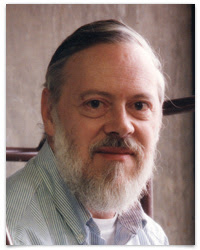If you liked the post, Share on Facebook, Tweet and Google Plus (use buttons above). You can also Subscribe to our feed via Email for free.
Home » Programming » C Programming Language History
C Programming Language History
C Language is a high level general-purpose computer programming language which was created between 1969 and 1973 by Dennis Ritchie. It is structured, high-level, machine independent and the most popular programming language in the world.

Dennis Ritchie
Development History
C continues to be one of the most robust languages in the world and has influenced many other programming languages. Let us check out History of C Language in details.
ALGOL, BCPL & B Language
It all started when a computer language ALGOL called the root of all modern languages was introduced in early 1960s. ALGOL gave the concept of structured programming to the computer science world.
As time passed, several languages which used block structured were developed. In 1967, a language called BCPL (Basic Combined Programming Language) was developed by Martin Richards and later in 1970, Ken Thompson created a language which was simply called B which inherited many features of BCPL.
When the PDP-11 computer arrived at Bell Labs, C language was developed using the features of ALGOL, BCPL and B by Dennis Ritchie at Bell Laboratories in 1972.
K&R C
In 1978, Brian Kernighan and Dennis Ritchie published a book named "The C Programming Language". C language became more popular after publication of this book. The book was so popular that the language came to be know an K&R C among the programming community.
ANSI/ISO C
Various improvements were made in C Language and various versions were created which were similar but often incompatible. In 1983, the American National Standards Institute (ANSI) formed a technical committee, X3J11, to establish a standard specification of C. This committee approved a version of C in 1989 which was ratified as ANSI X3.159-1989. This version of C Language is called ANSI C or Standard C or C89.
In 1990, the ANSI C standard was approved by the International Organization for Standardization (ISO) as ISO/IEC 9899:1990 which is called as C90. After adaptation of ANSI C by ISO it was referred as ANSI/ISO C.
C99, Embedded C and C1X
C99
The C standard was further revised in the late 1990s. In 1999 a new standard was approved by ISO which is commonly termed as C99. It extends the previous version (C90) with new linguistic and library features, and makes a better use of available computer hardware and compiler technology.
Embedded C
Embedded C is a set of language extensions for the C Programming language by the C Standards committee to address commonality issues that existed between C extensions for different embedded systems. In 2008, the C Standards Committee published a technical report to address these issues by providing a common standard for all implementations to adhere to. It includes a number of features not available in normal C, such as, fixed-point arithmetic, named address spaces, and basic I/O hardware addressing.
C1X
C1X is the unofficial name of the new planned standard for the C programming language. It is intended to replace the existing C standard, also known as C99. This new version mainly standardizes features that are already supported by common contemporary compilers in an implementation-defined way.
Conclusion
Dennis Ritchie has made a great contribution to the computer science field by developing C Language. Dennis Ritchie is also the co-founder of the UNIX operating system which was developed in C Language. He passed away at the age of 70 years on 12th October 2011. He will be always remembered historically for his great contributions.
Because of C Language's convenience and powerful features, it seems that C Language will continue to dominate the programming world.


0 comments:
Post a Comment